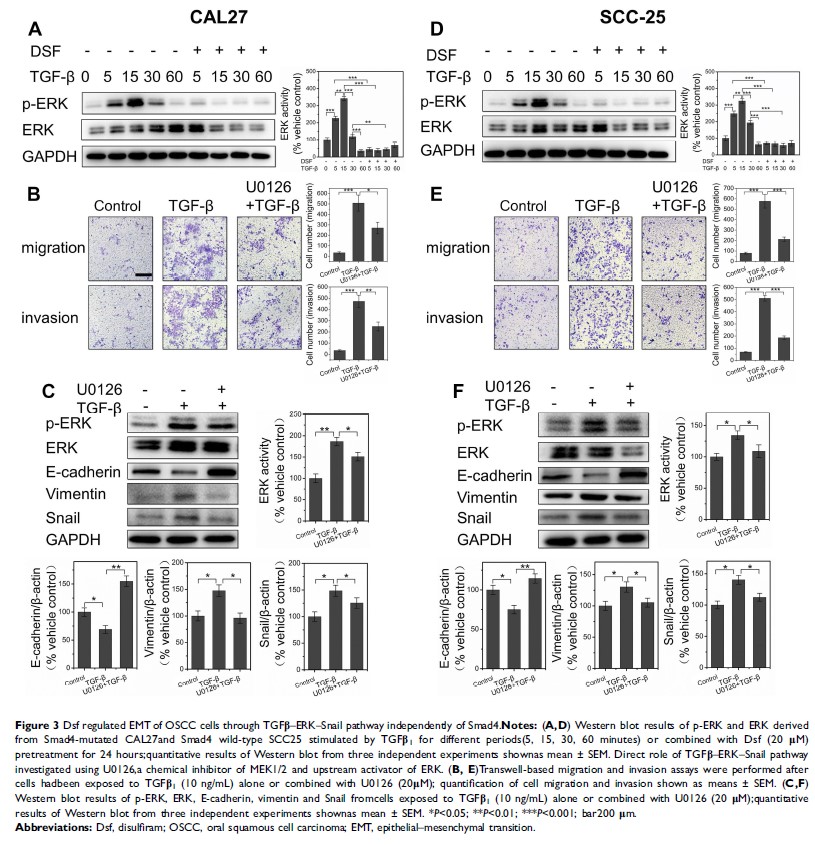9 1 2 3 6
论文已发表
注册即可获取德孚的最新动态
IF 收录期刊
- 2.6 Breast Cancer (Dove Med Press)
- 3.9 Clin Epidemiol
- 3.3 Cancer Manag Res
- 3.9 Infect Drug Resist
- 3.6 Clin Interv Aging
- 4.8 Drug Des Dev Ther
- 2.8 Int J Chronic Obstr
- 8.0 Int J Nanomed
- 2.3 Int J Women's Health
- 3.2 Neuropsych Dis Treat
- 4.0 OncoTargets Ther
- 2.2 Patient Prefer Adher
- 2.8 Ther Clin Risk Manag
- 2.7 J Pain Res
- 3.3 Diabet Metab Synd Ob
- 4.3 Psychol Res Behav Ma
- 3.4 Nat Sci Sleep
- 1.9 Pharmgenomics Pers Med
- 3.5 Risk Manag Healthc Policy
- 4.5 J Inflamm Res
- 2.3 Int J Gen Med
- 4.1 J Hepatocell Carcinoma
- 3.2 J Asthma Allergy
- 2.3 Clin Cosmet Investig Dermatol
- 3.3 J Multidiscip Healthc

双硫仑,独立于 Smad4,通过 TGFβ-ERK-Snail 通路抑制上皮 - 间质转化,减少口腔鳞状细胞癌转移
Authors Bu W, Wang Z, Meng L, Li X, Liu X, Chen Y, Xin Y, Li B, Sun H
Received 30 December 2018
Accepted for publication 7 April 2019
Published 1 May 2019 Volume 2019:11 Pages 3887—3898
DOI https://doi.org/10.2147/CMAR.S199912
Checked for plagiarism Yes
Review by Single-blind
Peer reviewers approved by Dr Colin Mak
Peer reviewer comments 3
Editor who approved publication: Professor Nakshatri
Purpose: Smad4
loss is highly related to poor prognosis and decreased patient survival in oral
squamous cell carcinoma (OSCC), suggesting that agents that target both
Smad4-mutated and Smad4 wild-type cells could treat OSCC more effectively.
Disulfiram (Dsf) has anticancer activity through a variety of mechanisms,
including inhibition of epithelial–mesenchymal transition (EMT). It remains
unclear whether Dsf has the same effect on Smad4-mutated and Smad4 wild-type
OSCC or not and what mechanism is involved.
Methods: Effect of
Dsf on TGFβ1-induced EMT in CAL27 (Smad4 mutation) and
SCC25 (Smad4 wild-type) cells were evaluated through analyzing changes in
morphology, expression of EMT markers, and migration and invasion of cells. The
ERK-pathway inhibitor U0126 was used to confirm TGFβ–ERK–Snail pathway–mediated
cell behavior. Dsf’s effects on tumor growth and metastasis in vivo were
examined through a subcutaneous xenograft mouse model and an intravenous tumor
mouse model.
Results: Dsf
inhibited TGFβ1-induced EMT through suppression of
morphological change, EMT-marker expression, and cell migration and invasion in
both CAL27 and SCC25. Phosphorylation of ERK and expression of Snail were
blocked by Dsf treatment. Like Dsf, U0126 had a similar effect on EMT of CAL27
and SCC25. Dsf also reduced tumor growth and metastasis in vivo, accompanied by
decreased expression of EMT markers in tumors.
Conclusion: These
results indicated that Dsf inhibited EMT of OSCC in vitro and in vivo
independently of Smad4 through suppression of the TGFβ–ERK–Snail pathway,
suggesting the broad-spectrum anticancer potential of Dsf for clinical use
against OSCC.
Keywords: disulfiram,
epithelial–mesenchymal transition, Smad4 mutation, oral squamous cell carcinoma
